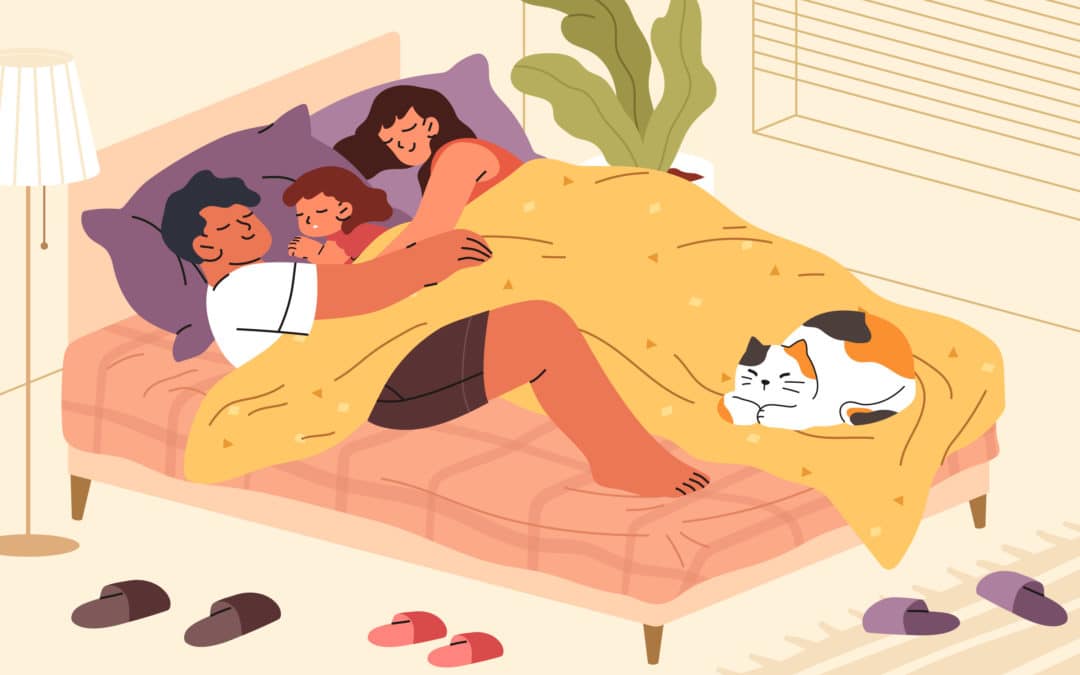For many parents, co-sleeping seems to be the most natural thing in the world.
For others, it is the last resort.
There are times when co-sleeping (or close proximity sleeping) reinforces bonding and makes breastfeeding less disruptive and more satisfying; at other times, mainly as infants develop (6 months+), they grow increasingly capable of social interaction and less dependent on constant physical contact. No one doubts this can be stressful for both infant and parent, but recent research and modern technology can ease the process. Even so, there are pitfalls and choices.
Co-sleeping, the pros and cons
In most circumstances, a parent’s instinct is to protect their offspring from danger, and historically, this is represented by the mother sitting with a babe in arms (typically in a feeding position) and the father standing watching- on guard.
In the 21st century, these instincts remain. But in our ever-changing socio-economic environment, vague legislation, and conflicting advice, decisions such as deciding on the safest place for your baby to sleep are a parental nightmare.
There are approximately 3,500 sleep-related (sudden unexpected infant deaths [SUIDs]) among US babies (< 12 months old) each year. When considered nationwide, this is a relatively small number (approximately 1 per 100,00 live births).
SUID is, however, the third leading cause of infant death in the US and is an ever-present concern for every parent or carer of a newborn infant. Each will do their utmost to protect the child in their care.
Public health authorities and pediatricians commonly take the position that mothers or anyone in the role of carer for an infant who sleeps in the same bed (or for whatever reason in a chair or couch) is putting the infant at increased risk of a SUID event. Although statistical evidence may support this conclusion, public health agencies and formal pediatric organizations take little or no consideration of the emotional and practical benefits claimed by many thousands of practicing co-sleepers. If you, your partner, or a carer choose, for pragmatic reasons, to co-sleep with an infant in your care, you can take comfort in the knowledge that you are not alone. Social media are awash with mothers who co-sleep with their infant children and are keen to share their experiences.
The American Academy of Pediatrics task force on sudden infant death syndrome (Chair, Dr. Rachel Moon) opposes co-sleeping under all circumstances. Dr Morton acknowledges that parents and carers may have to compromise on safe sleep measures.
Pediatricians and public health agencies are primarily guided by the ‘Triple Risk Model’ when it comes to assessing the causes of sudden infant deaths.
- The baby is at a critical stage of development – usually the first three months
- The baby has an underlying vulnerability, such as brainstem abnormality or other disease that cannot be detected at birth
- The baby is exposed to an outside triggering event that may compromise their airways, even briefly, such as a parent’s body, a stuffed animal, or an over-bundled infant in heat stress
(Dr H Kinney, American Academy of Pediatrics, AAP))
The Triple Risk theory suggests that any one of these conditions can cause sudden infant death, but the risk is highest when all three interact simultaneously. The third category, ‘outside triggering events,’ causes most problems for parents and carers when assessing the pros and cons of co-sleeping.
The APP does not endorse having an infant sleeping in an adult bed, as this increases the risks associated with SUID. The AAP recommends sharing a room but not sharing a bed.
Whether you bed share (co-sleep) or not, you can markedly decrease the risk of sudden unexpected infant death by following the Safe Sleep Seven guidelines.
- Do not smoke, take drugs (recreational), consume alcohol or take medication (prescription or OTC)
- Place the baby flat, directly on the mattress, at breast or chest height (as though breast or bottle feeding)
- Whether bed-sharing or not, the baby should be lying flat on its back (supine)
- Dress the infant lightly in no more than one additional layer than an adult would wear to be comfortable
- The surface on which the baby sleeps should be firm, i.e., hardly indented when the baby is laid down. The sleep surface should be horizontal and firm at the edges. Avoid putting a baby to sleep on a couch, chair, or any surface where they could roll and fall off
- Cords of any type are a choking hazard for infants. Ensure that none are within reach of even the most active baby. Gaps between the sleeping surface and any other surface, e.g., a wall, crib side, or even the slats in the crib’s base, should not exceed 23/8 inches (6cms) to minimize the chances of the baby getting stuck between them
- Whether bed-sharing or sleeping in a separate space, your baby should not have bedding sheets/comforters) that might cover their head, risking suffocation. Equally, it would be best to avoid the natural temptation to place any form of soft, cuddly playthings anywhere within possible reach.
Most medical organizations in the United States maintain the position that the risks of co-sleeping outweigh the advantages. The standard advice is to share a room; do not share a bed.
However, there is growing awareness that bed-sharing is not only a common practice in many other countries but also widely practiced in the USA. Consequently, the pediatric community is placing greater emphasis on research into the pitfalls and potential benefits of bed-sharing. The outcome may be a revision of the guidance on bedshare safety.
In the meantime, whether sharing a room or bed with an infant, the widely approved SAFE SLEEP SEVEN guidelines offer balanced advice to parents and carers on providing a safe sleeping environment for infants in their charge.

